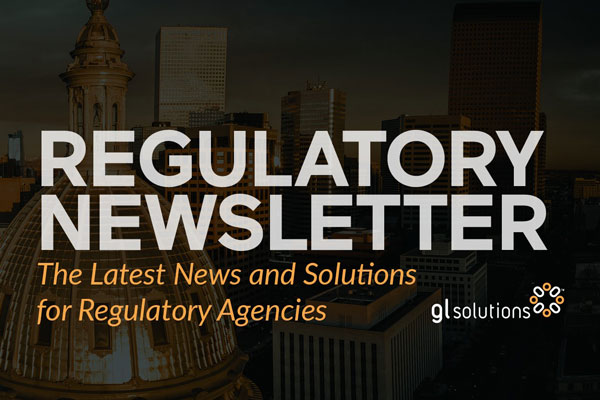Learn simple ways to integrate artificial intelligence into your regulatory agency’s everyday business processes—today. And hear how AI benefits your agency workforce, helping you automate routine tasks, increase consistency, reduce errors and enable 24/7 operations.
Amy Glasscock, Program Director for Innovation & Emerging Issues at the National Association of State Chief Information Officers shares how NASCIO formed a group to support government leaders with AI at their organizations.
We interviewed Ryan Pedersen, VP of Strategy at GL Solutions, who oversees product and application development for some simple AI work hacks.
Artificial intelligence (AI) offers the potential to transform how your government agency operates and serves citizens. AI drives significant efficiency gains through the automation of routine administrative tasks. By offloading repetitive, rule-based work to AI systems, artificial intelligence enables your agency to reallocate staff resources to higher-value activities that require human judgment, creativity, and expertise.
Create PowerPoint Presentations
“Staff at regulatory agencies can take a Word document and easily switch that into a PowerPoint or into an email,” says Pedersen. “It’ll summarize all of that for you.” A simple Google search reveals a host of products that help you turn your documentation into a presentation.
Compile Training Materials
“If you need to train a new employee and you have a long employee manual, AI can generate a PowerPoint from that,” explains Pedersen. ChatGPT offers “excellent results” in the “summarization of large documents for policymakers,” according to a July 6 StateTech article.
Compose Team Emails
“You can ask ChatGPT to write really encouraging emails to your teams or to your departments,” Ryan points out. Make sure you involve a human in checking any AI-generated text to avoid incorrect information; as ChatGPT cautions: It’s important to note that while AI offers many benefits, it’s not a replacement for human expertise.
Assist Your Constituents
Employ a chatbot to help your agency’s staff answer the stream of constituent calls and emails. “A constituent can ask a chatbot questions,” says Pedersen, “like how much liability insurance do I need? And it will respond back with the answer, so that people don’t have to go searching through an agency’s website—or have to call them.” A May article from PublicCEO gives further examples of how states harness the power of chatbots to support residents. “State and local governments have been utilizing chatbots for several years as a search engine to assist residents in finding the right information on various topics such as DMV services, unemployment claims, and rental assistance.” AI answers basic questions about renewing licenses, applying for permits or scheduling appointments. It can also provide step-by-step instructions to your constituents on completing forms or navigating online applications.
The possibilities for using AI to accomplish simple agency tasks quickly and efficiently constantly evolve. Learn a few more work hacks for using AI at your regulatory agency:
Summarize Lengthy Documents
AI automatically summarizes lengthy documents, saving your employees time and effort. This is particularly helpful for legal documents and complex regulations, where AI summarizes legal language and code to make it easier for non-legal staff to understand. Or use AI to create short summaries of agency reports for the public to quickly grasp key findings. For example, summarize key points about a disease, including symptoms and preventative measures for public health brochures.
Make Agency Communications Accessible
Use AI to easily translate your agency’s public service announcements into multiple language for diverse communities. Convert written transcripts of public meetings into closed captions for hearing-impaired viewers or translate public documents into sign language from deaf constituents. AI even offers text-to-speech options on your agency website to assist visually impaired users.
Monitor Social Media
Social media offers a powerful platform for citizens to express their opinions, share information, and engage with government entities. However, manually monitoring social media channels takes staff time, given the vast amount of data generated. Use AI to monitor social platforms such as Twitter, Facebook, Reddit and others for mentions of your government agency or specific topics of interest, allowing for more timely response to concerns or misinformation.
Start simple with AI. Start with a few repetitive tasks for AI to automate and then scale up as you gain experience. As always with AI, involve humans in the final decision-making process. AI remains a powerful tool, but should not replace human judgment.
AI Resources:
NASCIO Generative AI Working Group
The National Association of State Chief Information Officers formed a Generative AI Working Group and started meeting in July 2023. According to Amy Glasscock, NASCIO’s Program Director for Innovation & Emerging Issues, “our NASCIO Generative AI Working Group is a group made up of any interested NASCIO members. We meet once a month to talk about issues related to generative AI in state government. We often have presentations from states on generative AI policies, regulations and use cases.”
AI News and Government Regulatory Agencies
For the latest articles about artificial intelligence, head to our new page, AI and Government Regulatory Agencies.
AI offers endless possibilities for automating routine tasks at state regulatory agencies. Does your regulatory agency already integrate AI into your work processes? We would love to hear more. Please reach out to us at editor@glsolutions.com. Thank you!
Run, Grow and Adapt
Subscribe to our newsletter to receive the latest regulatory news delivered to your inbox each week.
GL Solutions helps governments run, grow and adapt. To learn more, explore our website, call us at 800.930.1193 or email us at hello@glsolutions.com.


